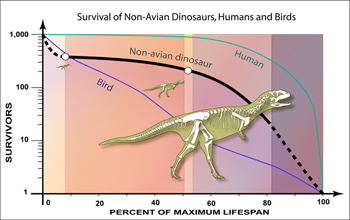News Release 06-106
Paleontologists Establish First Age Distribution of Non-Avian Dinosaur Population
As with modern animals, surviving infancy was hardest

Paleontologists have uncovered the ages of a population of non-avian dinosaurs.
July 13, 2006
This material is available primarily for archival purposes. Telephone numbers or other contact information may be out of date; please see current contact information at media contacts.
For the first time, scientists have established the age structure of a non-avian dinosaur population. Using this information, they inferred which factors led to survival or death of group members.
Did these animals show survival patterns akin to extant living dinosaurs, the birds, as did their crocodilian cousins? Or, did they mirror that of more distantly related dinosaurs that lived in a similar environment? A pile of bones from the North American tyrannosaur Albertosaurus sarcophagus may hold the answer.
These animals "showed exceptional survivorship once they passed the hatchling stage," said Gregory Erickson of Florida State University, co-author of a paper reporting the results in this week's issue of the journal Science.
"Factors such as predation and [timing of] entrance into the breeding population may have influenced survivorship," the researchers say. Such patterns are common today in wild populations of long-lived birds and mammals.
Why increased survivorship as juveniles? "In living populations it occurs because animals reach threshold sizes, and predation pressures decrease," said Erickson. "By age two, most tyrannosaurs were as large or larger than nearly all other predators in their realm."
"Because most species of non-avian dinosaurs are known from just one or a few specimens, very little is understood about the population biology of these animals," said Richard Lane, program director in the National Science Foundation (NSF)'s Division of Earth Sciences, which funded the research."We now have a breakthrough in unraveling these dinosaurs' life cycles."The burial site was first found and partially excavated in 1910 by famed dinosaur hunter Barnum Brown of the American Museum of Natural History, who discovered it along the Red Deer River in Alberta, Canada. The site was recently reopened by scientists from the Royal Tyrrell Museum of Palaeontology in Alberta, Canada, on an expedition led by co-author Philip Currie of the University of Alberta, Edmonton.
Erickson, Currie, Brian Inouye of the University of Alberta, and Alice Winn of Florida State University, established how many dinosaurs had died at the site. They concluded that at least 22 individuals ranging from 2 to 28 years old were buried there, and found considerably more adult specimens than juveniles.
They then studied and aged other North American tyrannosaurs. "These specimens had been found individually throughout various formations in the United States and Canada," said Erickson. "We found the same situation--very few young animals--again."
-NSF-
Media Contacts
Cheryl Dybas, NSF, (703) 292-7734, email: cdybas@nsf.gov
The U.S. National Science Foundation propels the nation forward by advancing fundamental research in all fields of science and engineering. NSF supports research and people by providing facilities, instruments and funding to support their ingenuity and sustain the U.S. as a global leader in research and innovation. With a fiscal year 2023 budget of $9.5 billion, NSF funds reach all 50 states through grants to nearly 2,000 colleges, universities and institutions. Each year, NSF receives more than 40,000 competitive proposals and makes about 11,000 new awards. Those awards include support for cooperative research with industry, Arctic and Antarctic research and operations, and U.S. participation in international scientific efforts.
Connect with us online
NSF website: nsf.gov
NSF News: nsf.gov/news
For News Media: nsf.gov/news/newsroom
Statistics: nsf.gov/statistics/
Awards database: nsf.gov/awardsearch/
Follow us on social
Twitter: twitter.com/NSF
Facebook: facebook.com/US.NSF
Instagram: instagram.com/nsfgov


